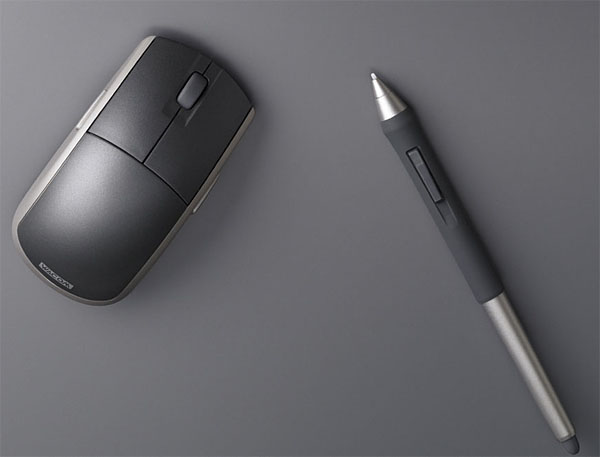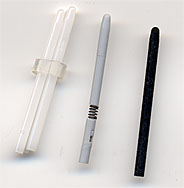
 |
| Home • Reviews • Forums • News 2015 • 2013 • 2012 • 2009 • 2008 • 2007 • 2006 • 2005 • 2004 RSS Feeds • FOV Factor Table • Sensor Sizes | Definitions: A-D • E-H • I-L • M-P • Q-U • V-Z | Sitemap Articles • Archived Websites (Pre-DigitalDingus): D100 Lounge • E-10 Club | Contact |
| Wacom Intuos3 6x8 |
| Pen & Mouse October 14, 2005 |
| Introduction • The Intuos3 • ExpressKeys & Touch Strips • Pen & Mouse • Software Bundle Tutorials • Intuos3 Exercises (Part 1) • Intuos3 Exercises (Part 2) • Intuos3 Exercises (Part 3) How Do They Do That? • Specifications • Conclusion
|
Continuing on, let's take a look at the pen and mouse you will be using with the digital tablet, in addition to extra nibs and two other special nibs. The Pen The Intuos3 pen is a non-battery required, no-magnet-inside piece of technological marvel. The benefits of not having magnets and batteries ensure you get the most natural fitting pen available. This is what separates Wacom from the others. Batteries will certainly add an un-natural weighty feeling to the pen, and instead of concentrating on your work, you'll be concentrating more on just how heavy the pen feels and how the weight distribution doesn't feel right. If you've ever held a pen for hours, you'll know that the first 15 minutes are fine. It's when 30-minutes pass, and then an hour, when your hand muscles begin to notice just how heavy the object is your holding. How does Wacom avoid batteries and magnets? Well, this technical question is explained in depth in the How Do They Do That? section of this review. Just in case the switch on the pen is not to your liking, it is possible to remove it. In my particular experience with the Intuos3 tablet, I haven't found the need to remove it, but Wacom has provided that option and possibility for you. The Nibs
I would also recommend trying the different nibs out on your pen after a few tries with the regular white nibs. I can say the Felt nib did have more real-life friction, resembling that of a pencil on paper. So, if you're using the white nibs, and just don't have a "connection" with your tablet, I highly suggest using the other two nibs.
IMPORTANT NOTE: The nibs are included in the plastic packaging with the pen, but it is VERY easy to lose them when you're opening the package, so be very careful when you do. Maybe in the future Wacom can possibly package these tiny things separately in a rectangular box or something.
The Mouse
It's a stylish moush, and I must say it feels very nice in my hands. The mouse Wacom supplies functions on an average level, just doesn't have the accuracy as the pen does. After using it for extended periods of time, I think the mouse should only be used with the Wacom system if you still have the ancient rubber trackball mouse which has your breadcrumbs accumulated from the last 10 years. Personally, I still use the Microsoft optical mouse because it's much more accurate. Most computer users should have an optical mouse by now as they are very inexpensive ($30 or less). The Wacom mouse does ok, but does tend to have information/location delay issues if ever so slightly. This could be related to the surface area of the mouse versus the very small and pen-point accuracy of the pen. There are options in the Wacom Tablet Control Panel (WTCP)
Should you use it? Well, like I said, it depends. Wacom was respectful by including a mouse, and for some new tablet users, will come in handy. The mouse only operates on the area of the tablet itself, so you have severe restrictions, in my opinion. Most people will use their existing mouse to the side, and use the pen with the tablet. For Intuos2 users, a mouse might be more of a necessity since the area of the tablet is around 4-times as large. These are some seriously large tablets and take up a lot of space, and I can see where a mouse would be useful in their applications. But anything smaller, I'm not so sure. Even the Intuos3 9x12 version could be a little too small. In any case, it's nice to have Wacom include a mouse, so you can decide whether or not it will be of a convenience to you. |
| Home • Reviews • Forums • News 2015 • 2013 • 2012 • 2009 • 2008 • 2007 • 2006 • 2005 • 2004 RSS Feeds • FOV Factor Table • Sensor Sizes | Definitions: A-D • E-H • I-L • M-P • Q-U • V-Z | Sitemap Articles • Archived Websites (Pre-DigitalDingus): D100 Lounge • E-10 Club | Contact |
| RELATED REVIEWS Wacom Intuos3 6x8 October 7, 2005 |
 Wacom supplies you with three extra Standard Nibs, a Stroke nib, and a Felt nib. The standard nibs are the white, and there is one already included in your pen for you to use as soon as you get the Wacom tablet up and running. The stroke nib has extended tip travel and also has more of a "brush" feel and response (the nib with the spring shown on your left). The felt nib was created to create more resistance between it and the pen tablet, which results in a "pencil-on-paper" type of feeling (the black nib).
Wacom supplies you with three extra Standard Nibs, a Stroke nib, and a Felt nib. The standard nibs are the white, and there is one already included in your pen for you to use as soon as you get the Wacom tablet up and running. The stroke nib has extended tip travel and also has more of a "brush" feel and response (the nib with the spring shown on your left). The felt nib was created to create more resistance between it and the pen tablet, which results in a "pencil-on-paper" type of feeling (the black nib).